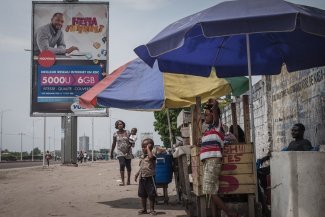
The Ukhahlamba-Drakensberg mountain range in South Africa, listed as a World Heritage Site by UNESCO, is an example of the imposition of a western concept, focused on the preservation of nature to the detriment of the interests of the indigenous populations.
In 1972 the United National Education, Science and Cultural Organisation (UNESCO) adopted its Convention Concerning the Protection of the World Cultural and Natural Heritage leading to its famous list of world heritage sites, an inventory of sites considered of outstanding universal value.
More than 1,000 sites are now included on this prestigious list. Italy has the most sites listed, with 53 entries, France is in fourth place with 43 sites, but some countries in the southern hemisphere, such as Rwanda and Liberia, have none.
The World Heritage Fund, which manages these sites, has an annual budget of US$2.5 million, a very modest budget compared to UNESCO’s total annual budget of US$333 million, but the symbolic value of this world heritage list is very high.
The classification can give rise to major economic and geopolitical tensions. With Africa badly under-represented on the world heritage list, accounting for less than 10 per cent of sites, it also reflects the North-South imbalance.
As Mechtild Rössler, director of UNESCO’s World Heritage Centre explains, “developing countries often lack the institutions needed to support this process. We help African countries thanks to the World Heritage Fund, the African Heritage Fund, and a specific programme.”
Mrs. D, a former UNESCO staff member who wishes to remain anonymous, who worked at the World Heritage Centre from 2001 to 2012, adds: “Submitting an application for the classification of a site on the list is very expensive, and it requires expertise to prepare a nomination, which African countries don’t have. Moreover, a listed site has to be managed according to a management plan, and the listed site must be preserved at the expense of the government. Many poor countries do not have the expertise to draw up a management plan or the means to finance the preservation of a site.”
“Sometimes,” she continues, “the population of a country may be opposed to the listing of a site. The population’s priorities are usually to have hospital, schools and infrastructure.”
UNESCO has in many cases helped preserve African culture, thereby contributing to saving its heritage. As Rössler explains: “In January 2013, UNESCO and the Government of Mali began a huge programme to restore Mali’s cultural heritage, which includes notably the reconstruction of mausoleums, conserving ancient manuscripts and reconstructing damaged monuments.”
But, Mrs. D. says: “States use UNESCO’s world heritage list for their own purposes all the time. It’s about national and international prestige, and economic and even political games.”
In their study on the Osun Osogbo Sacred Grove (in Nigeria, and included on the World Heritage list since 2005), Saskia Cousin and Jean-Luc Martineau show the important role of lobbying, for political and economic stakes.
In this specific case the political aim was to give the Osun state’s new capital some historical background, which it was lacking, when in competition with the rival town of Ife-Ife, which has more history.
UNESCO’s World Heritage list has become an implement of legitimisation, using culture for political and economic ends.
“The post-colonial domination of Africans”
Being included on the list of world heritage sites can also have a negative effect on the local population. In Ethiopia, for example, the classification of the Simien National Park, at the request of Emperor Haile Selassie, as a World Heritage site since 1978, meant that the area was preserved to the detriment of the people living there, who were prohibited from practising their traditional activities.
Then in the 1980s, UNESCO recommended that the population be removed from the site to preserve the eco-system. In reality, UNESCO was being used, as the historian Guillaume Blanc has shown, because this was the period of the Mengistu dictatorship and Simien had become a refuge for his political opponents.
The eviction of the local population from the mountain range served the ends of the rulers of the day, therefore. In general terms, the park became an example of what in 1995 historian Martin Melosi called “eco-racism”, and would appear to be a “post-colonial continuation of the domination of the Africans by the Whites.”
Another example, in South Africa, illustrates how the declaration of a heritage site can sometimes be to the detriment of the local inhabitants and their culture. A case in point was the inclusion of the Ukhahlamba-Drakensberg mountain range on the list. The mountains were classified as part of the world’s “natural” and “cultural” heritage in 2000, owing to the beauty of the landscape and the cave paintings.
The process of proposing the site and classifying it took place in parallel to the ending of apartheid in 1994. The new post-apartheid government hoped to use tourism to improve the lot of the black population and combat social inequality.
But the classification as a World Heritage site was essentially a “top-down” process, decided on from above by the government, without involving the population concerned.
The cave paintings by the indigenous populations have not attracted many tourists. Furthermore, turning the site into a tourist destination meant that it was closed to the local inhabitants who wanted to continue practising the traditional Eland ceremony.
The “Unescoisation” of the site has meant the imposition of a western concept, focused on preservation, to the detriment of the interests of the indigenous peoples.
A final example is UNESCO’s launching of the “Slave Route” in 1994. The route begins in Benin, in the coastal town of Ouidah, which was one of the largest slave-trading ports in Africa. UNESCO has established an itinerary that follows the key sites in the history of the slave trade, such as the Tree of Forgetfulness and the auction site.
According to historian Robin Law, in reality not all these sites honoured by UNESCO are historically authentic: there never was an “auction site” for example.
Mrs. D. adds that, similarly, the Ile de Gorée in Senegal, where a memorial site was built by the UNESCO Slave Route programme, “was in fact by no means the major site from which the majority of slaves left. The memorial is fabricated.”
In fact, for states there are huge advantages to having a site included on UNESCO’s World Heritage list. It can have a very strong economic impact. Hence the fervent wish and geopolitical rivalry of states to get a site included on the list, to benefit from the financial windfall.
UNESCO’s budget is too small for it to redress the imbalance between States in terms of heritage. The organisation is in fact under-funded: the United States owes UNESCO US$543million in arrears, having paid nothing since 2011 (in retaliation for Palestine’s membership of the organisation).
At a time when tourism is becoming a massive global phenomenon (it involved over a billion people in 2015 and generated earnings of 1,500 billion dollars) the seemingly apolitical and consensual notion of “world heritage” actually entails high political, economic and geopolitical stakes for the image and ranking of states on the international scene.









